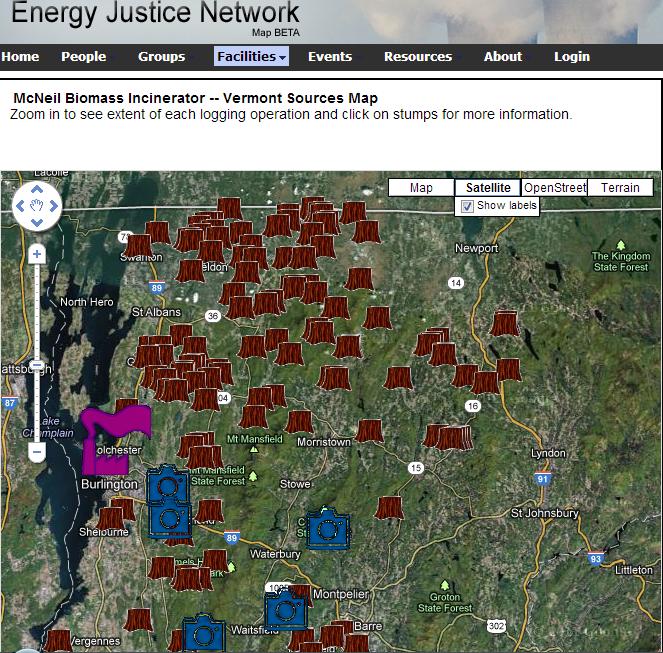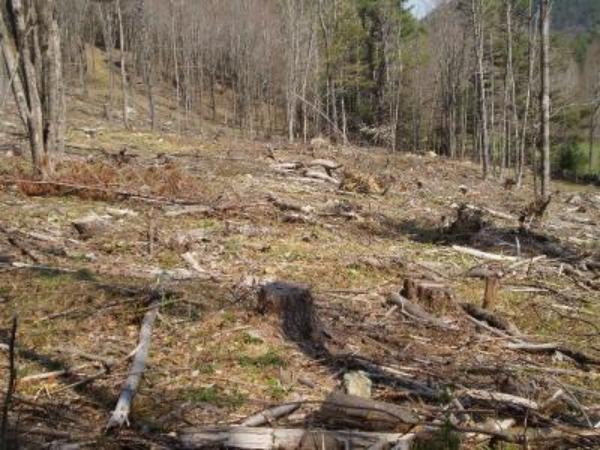|
|
FORESTS FALL, LUNGS FAIL
(The Biomass Monitor: February 2013 - Vol. 4, issue 2)
Electronic Map Tracks Logging for Biomass Energy
The first and only electronic map tracking logging sites sourcing wood to a biomass energy facility has been released by Energy Justice Network, a Washington, DC-based nonprofit organization with field offices in Vermont, Pennsylvania and Oregon and Biofuelwatch, an international organization based in Vermont and the UK.
The initial phase of the McNeil Biomass Forest Mapping Project—funded by a grant from the Fund for Wild Nature—maps logging sites in Vermont that provided wood to the McNeil Generating Station in 2010, a 50-megawatt biomass power incinerator in Burlington. The map overlays nearly 150 forest sites logged in 2010—along with several photo galleries—on a satellite map of Vermont using Google Maps.
Each logging site is marked with an icon of a stump with further zooming in revealing a transparent blue polygon outlining the exact location of the cutting. Clicking on the stump brings up relevant data including acreage, town, property owner, logger, forester, date logged, and documentation of the associated scans taken from Vermont Fish and Wildlife Department maps.
The McNeil project is integrated into Energy Justice Network’s Dirty Energy Mapping Project which pinpoints the locations of existing and proposed biomass and waste incinerators, nuclear reactors, natural gas and coal-fired power plants in the US and documents grassroots community resistance to those facilities. Once completed, the McNeil Biomass Forest Mapping Project will map logging for both the McNeil station and the 25-megawatt Ryegate Biomass Incinerator (in Ryegate, Vermont) over a ten year period from 2002-2012 to depict the actual forest footprint of industrial scale biomass energy... READ MORE

Green Group Appeals California Biomass Proposal
Center for Biological Diversity, a national nonprofit environmental organization based in Arizona, is appealing a December 2012 Placer County Planning Commission decision to adopt a conditional use permit and certify the Environmental Impact Report (EIR) for the Cabin Creek Biomass Energy Facility. Center for Biological Diversity (CBD) alleges that the EIR for the 2.2-megawatt biomass power incinerator “does not comply with the California Environmental Quality Act.”Cabin Creek biomass incinerator is proposed for a site two miles from 16,000-resident Truckee and within 1,500 feet of the nearest residence. The facility had previously been proposed for Kings Beach on the northern shore of Lake Tahoe but was relocated following fierce opposition from community residents.
The goal of the Center’s Climate Law Institute, which is undertaking the appeal through the efforts of its San Francisco-based Senior Attorney Kevin Bundy, is “to reduce U.S. greenhouse gas emissions and other air pollution to protect biological diversity, the environment, and public health.” Biomass incineration, “although often touted as a ‘clean’ alternative to fossil-fueled generation, has potentially significant environmental impacts of its own,” according to the Center’s comments... READ MORE
The Cellulosic Myth
- by Brian Tokar [Excerpted from "Biofuels and the Global Food Crisis," in Fred Magdoff and Brian Tokar, eds., Agriculture and Food in Crisis: Conflict Resistance, and Renewal, New York: MONTHLY REVIEW PRESS, 2010.]
As concerns about agrofuels’ implications for food supplies and the environment have become more widespread, proponents have reaffirmed their claims that current technologies are merely a “stepping stone” to more sustainable biofuel production from the cellulose in grasses and trees, rather than from food starches and oilseed crops. They predict that the world will soon obtain increasing yields of liquid fuel extracted from prairie grasses, logging wastes and forest thinnings, as well as agricultural byproducts such as straw and corn stover (i.e., leaves and stems).
The extraction of ethanol from these high-cellulose sources, however, is a complex, energy-consuming process involving many stages of enzymatic digestion and purification of breakdown products, followed by the fermentation of sugars into ethanol. Alternative processes, such as the high temperature gasification and distillation of cellulosic feedstocks—technically similar to the liquefaction of coal—have proven equally difficult to commercialize... READ MORE
 Logging for industrial scale biomass incineration in Vermont
Logging for industrial scale biomass incineration in Vermont
Laugh or Cry? Obama's New Commitment on Climate Change
- by Rachel Smolker, co-director of Biofuelwatch
In his inaugural address, President Obama spoke eloquently about his intent to address climate change, saying: "We will respond to the threat of climate change, knowing that the failure to do so would betray our children and future generations." Following on, the right-wing deniers predictably flew into a frenzy of obnoxious blather, largely serving to clog up the media. Meanwhile the liberals, progressives and enviros cheered with glee, as if the mere mention of the word "climate" were a big happy victory, a frankly pathetic display that I can only imagine the right-wing deniers found amusing. The spectrum of responses is a clear reflection of the extreme dysfunction of, most especially, Washington D.C. Even as Sandy smashed NYC to smithereens and prolonged drought decimated crops across the Midwest, the leader of the country most responsible for this frightening mess is so cowed by his detractors as to feel it necessary to wait until after his reelection to even mention that seven-letter word? Oh yay.
For climate justice activists, the question is: Should we laugh or should we cry? It has certainly been disturbing to watch Obama, facing the greatest threat to life on Earth ever (yes, far greater even than the economic crisis) fail to even utter that word. But, we are also aware that when he has in fact stepped up to the plate on climate, it has not usually been pretty. For example, in 2009, when, at the eleventh hour he flew to the UN climate negotiations in Copenhagen to push through, via the back rooms, a "made in the U.S." deal that removed any teeth from the negotiated agreement that had been painstakingly hammered out in accordance with participatory UN protocols. That showing in the international climate debate followed on the heels of years of U.S. interference and obstructionism, remarkable given that the we are not even a signatory to the Kyoto protocol... READ MORE
Beyond Burning: Solar Beats Biofuels for Powering Cars
- by Ken Kola, TGDaily.com
Photovoltaics (PV) technology is much more efficient than biomass at fueling a car, say researchers, making a mockery of the US 2005 energy bill that calls for more use of corn ethanol as a biofuel. Researchers examined three ways of using sunlight to power cars: the traditional method of converting corn or other plants to ethanol; converting energy crops into electricity for vehicles; rather than producing and using photovoltaics to convert sunlight directly into electricity for cars.
"PV is orders of magnitude more efficient than biofuels pathways in terms of land use - 30, 50, even 200 times more efficient - depending on the specific crop and local conditions," says University of California, Santa Barbara professor Roland Geyer. "You get the same amount of energy using much less land, and PV doesn't require farm land." Even the most efficient biomass-based technique requires 29 times more land than the PV-based alternative in the same locations, says the team. Photovoltaic systems for battery electric vehicles also have the lowest life-cycle greenhouse gas emissions throughout the US, and the lowest fossil fuel inputs, except in locations that have very high hypothetical switchgrass yields.
"The bottleneck for biofuels is photosynthesis," says Geyer. "It's at best one percent efficient at converting sunlight to crop, while today's thin-film PV is at least 10 percent efficient at converting sunlight to electricity." READ MORE
|
|
|
|
|
|
|